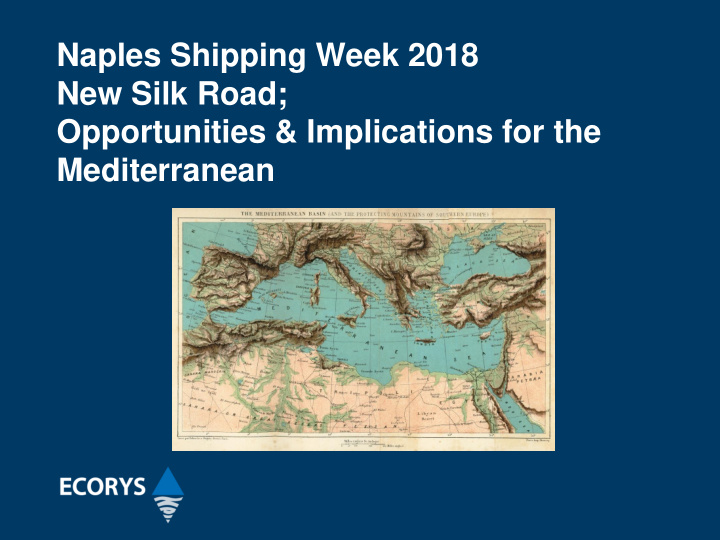



Naples Shipping Week 2018 New Silk Road; Opportunities & Implications for the Mediterranean
Introduction Onno de Jong – Consultant on Transport, Infrastructure and Mobility at Ecorys, an economic research and advisory firm headquartered in Rotterdam, The Netherlands Co-author of an article in the Italian Maritime Economy review (SRM) on implications of BRI on the European Port System. At Ecorys we have advised the Dutch Ministry of Foreign Affairs on (back then OBOR) and we still follow the topic very closely.
Topics for today • Background to the topic • BRI from a logistics point of view • Changing port landscape in Europe • Opportunities for Italy and the Mediterranean • Risks involved in the project • Concluding remarks
The Silk Road is not new Land based rail transport Japan – The Silk Road of Marco Polo Rotterdam (1968) , train 70% slower but 20% cheaper than ocean freight…
After the dissolution of the USSR the train loses it’s pace • Japan kept investing in the route up until the 1997 Asia Financial Crisis • By that time ocean freight was both faster and cheaper: 1997 cost per TEU China-Europe per ocean freight was USD 1200 and via rail USD 3500 • Main issues at that time: failing rail infrastructure (neglected maintenance, procedures (now independent states along the route), and (just as in the present day) the gauge problem
Fast forward to 2013: "Promote People-to-People Friendship and Create a Better Future" (launch of the New Silk Road “OBOR”)
The shifting economic core
A closer look at the different projects
Focus on the MENA region
Chinese port investment in Europe The 2013 Piraeus investment served as catalyst for a large stream of Chinese investments in the European port system:
The 2007-2016 balance of port regions
The European perspective • Still the main aim is reaching customers along the Rhine valley and the Southside of the Alps • New locations in Central and Eastern Europe emerge; new attractive base of customers (and logistics location) • Given these circumstances the North (Sea) – South (Med) competition is still on!
Key elements in the European port competition • Maritime side: ports need to adapt to (still) growing ship sizes . 23.000 TEU ships from MSC to enter service next year • Land side: pressure on hinterland connections, need for sustainable & efficient hinterland transport. Brenner Basetunnel as new connection?
The current value proposition of railfreight China-Europe Modality Transport Time Relative Cost Ocean freight +/- 35 days 100 (=basecase) China-Europe (=basecase) Rail China-Europe 14-16 days 200-300 Air freight China- 4 days 1000-1500 Europe • This implies that goods that have a high enough value density and are somehow time sensitive can be an attractive segment for rail transport. • Also from a working capital / supply chain finance point of view choosing a different modality can be interesting!
Cost of labor developments in China and costs of inland logistics very relevant • Within China labor costs have risen, especially in coastal regions (Shanghai, Guangzhou, Shenzen etc.). • Average salary 2017: – Shanghai province: 9,802 yuan ($1,420) – Chongqing: 6,971 yuan ($1,010) (Comparison: Italy €2400 (~$2,800)) • Move of production more inland China: further away from seaports. Cost of transport Chongqing-Shenzen around USD 850 per TEU • Given shift of Economic core of Europe to the east train becomes a viable alternative to ocean freight
Main trade partners of Italy
Steady growth of Italian exports to China
Italian exports: how are they built up? Link with China and the BRI initiative? Source: MIT OEC (2018, data for 2017)
Cooperation on Blue Economy: link with tourism?
Joint development of energy projects
Strategic shift of container flows • We see the integration of (Chinese) state owned shipping conglomerates with state owned terminal operating companies • Will we see Chinese controlled chains? And how will the relationship between business economics and strategic interests look like? • More investments by Chinese firms expected: both in terminals (because of opportunities) as in (container) shipping (to become more competitive)
Some experiences from BRI projects • Piraeus as example of ambitions and actual growth; number 93 worldwide in 2010, 44 in 2015 and 38 in 2017. Ambition to grow from 4.1 mln TEU to 10 mln TEU. • Projects financed by China are often constructed by Chinese firms (based on Chinese engineering) • Bail out of debt laden projects: 99 year lease of Sri Lanka’s Hambantota Port project to China • Tendering of projects not up to European standards: Budapest- Beograd railway as example of project with limited public procurement
Challenges of a destabilizing world 2018 Global Risk Map by Control Risks
Maritime risks for the MENA region Maritime Risk Map 2018 by Control Risks
Shifting balances with Northern Sea Route? Will the balance shift North again when the route opens? • Cosco launched ‘the Polar Silk Road’ claiming saving up to 20 days of sailing time compared to Suez • Maersk: series of seven 4000 TEU ships ordered that can use the route • Big question; when will this route be commercially viable (and reliable)?
Concluding remarks • Numerous maritime sectors present in Italy and China offer possibilities for cooperation; but be aware of importance of mutual benefits • Blue economy is becoming more and more a strategic sector for the Chinese economy: export possibilities for Italian expertise • Stability in the MENA region very important for future success • Long term development to be debated: Northern Sea Route as game changer?
Questions? Contact: onno.dejong@ecorys.com
Recommend
More recommend